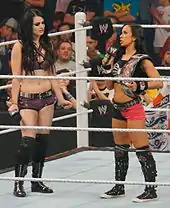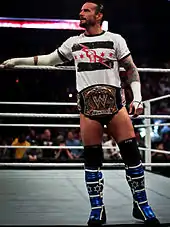PG Era
The PG Era is a period of professional wrestling within World Wrestling Entertainment, inc. (WWE), which began on July 22, 2008 after its programming received a TV-PG rating from the TV Parental Guidelines. WWE considers the era to have ended in 2013, but some sources describe everything since 2008 to be part of the PG Era because most of WWE's programming remains TV-PG. The era has received plenty of criticism due to its watered-down violence and family-friendly program and characters.
Background

WWE promoter Vince McMahon states that the Attitude Era of the 1990s and early 2000s was the result of competition from World Championship Wrestling (WCW) and forced the company to "go for the jugular". Due to WCW's demise in 2001, McMahon says that they "don't have to" appeal to viewers in the same way and that during the "far more scripted" PG Era, WWE could "give the audience what they want in a far more sophisticated way".[1] WWE says that the move to PG cut the "excess" of the Attitude Era and "ushered in a new era of refined and compelling storytelling".[2] John Cena was face of the company during this time, despite receiving a mixed reception from the audience.[2]
While WWE had been slowly moving towards a more family-friendly format before it, Vice News writes that this was accelerated after the Chris Benoit double murder and suicide in 2007.[3] Bryan Alvarez and Lance Storm of Wrestling Observer Newsletter attribute the move to TV-PG as a result of WWE appealing to sponsors.[4] Then-WWE CEO Linda McMahon described the transition away from TV-14 as a "cradle to the grave" approach to appeal to younger viewers and encourage brand loyalty.[5]
WWE officially announced the move to TV-PG on July 22, 2008.[6] The 2008 SummerSlam pay-per-view (PPV) was the first WWE PPV to carry the TV-PG rating.[7] To appeal to younger fans, WWE released the WWE Kids magazine in 2008,[8] and debuted the kid-friendly Saturday Morning Slam television program in 2012.[9]
Changes in content
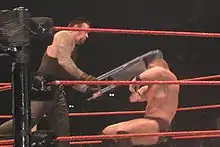
As WWE adapted a more family-friendly style, previous staples in their programming were altered or dropped. Use of profanity was toned down.[8] An example of this was when John Cena renamed his finishing maneuver from "FU" to "Attitude Adjustment" or the PPV event WWE One Night Stand changing the name to WWE Extreme Rules to avoid the sexual connotations.[10][11] Female wrestlers had previously performed in Bra and panties matches and several of them had posed nude in Playboy but these were dropped in 2008.[12] Excessive violence was also toned down. Chair shots to the head became increasingly rare after Benoit's death,[3] and were completely banned in 2010.[13] In 2011 following their match at WrestleMania 27, wrestlers The Undertaker and Triple H were fined for chair shots to the head, despite the match being well received by the fans.[14]
Amid declining ratings and the launch of rival promotion All Elite Wrestling in 2019, it was reported that WWE wanted to move on from the PG Era.[15] Vince McMahon acknowledged that the promotion would be "a bit edgier, but remain in the PG environment". He said the promotion had "graduated from ... gory crap" and was a "a more sophisticated product".[16]
Major storylines and stars
WWE considers the PG Era to have ended in 2013, in favor of The Reality Era,[17] although the exact duration of the era is disputed.[18][19] Many sources continue to describe WWE as still being in the PG Era because most of their content is still rated TV-PG.[20][15] For the purposes of this article, only events between 2008–2013 will be covered in the section. The Reality Era covers 2013–2016 and The New Era covers 2016–present.
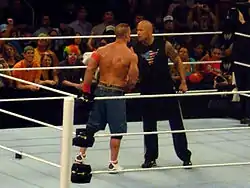
Bleacher Report states that "Perhaps the most distinguishable characteristic of WWE's PG Era was its reliance on superhero-esque babyfaces."[21] While John Cena was the biggest star in the company at that time, while other major stars during that period included Randy Orton,[22] Rey Mysterio,[8] Batista and Edge.[22] The heroic characters were often placed against villains such as Dolph Ziggler, Jack Swagger, Mark Henry, Big Show,[21] and The Miz.[23] Attitude Era alumni like The Undertaker, Triple H, Shawn Michaels and Chris Jericho continued to have prominent matches throughout this time,[18] and The Rock and Brock Lesnar returned to face Cena.[18] This era saw Batista's first departure in 2010,[24] and Shawn Michaels and Edge retired in 2010 and 2011 respectively.[22]
Women were not an integral part of the show and were treated as a sideshow during the early parts of the era, similar to how they were presented in the 1970s and 80s. However, AJ Lee, Paige and Nikki Bella were given greater prominence as time went on and paved the way for the "Divas Revolution" of 2015.[21]
During the PG Era, Jeff Hardy won the WWE Championship for the first time at Armageddon 2008.[18] His subsequent 2009 feud with CM Punk was described as "shockingly real" given the PG Era, as Punk referenced Hardy's real-life drug addiction. Their rivalry culminated in a match at SummerSlam, which Punk won, and Hardy subsequently left the promotion.[25] CM Punk became a "megastar" in the summer of 2011 during his feud with Cena,[25] the pinnacle of which saw him defeat Cena for the WWE Championship at Money in the Bank and SummerSlam respectively in two well-received matches.[18][26] During his storyline with Cena, Punk performed a shoot promo (known as The Pipebomb), with a style far away from the PG content.[27][28][29] Bleacher Report writes: "Punk turned the company on its head for a few short years and gave fans a taste of what an alternative to the advertiser-obsessed promotion could look like."[21]
Future stars such as Alberto Del Rio, Daniel Bryan, Drew McIntyre, The Wyatt Family (Bray Wyatt, Luke Harper and Erick Rowan) and The Shield (Roman Reigns, Dean Ambrose, Seth Rollins) made their debuts during this time.[18] The ECW brand was discontinued in 2010 and replaced with NXT, which serves as a developmental brand for the promotion.[18] The Nexus (a stable initially started out by 7 original members of NXT) storyline was heavily featured between 2010–2011, with the decision for Cena to dominate the entire stable throughout its existence being heavily panned by critics.[30][31]
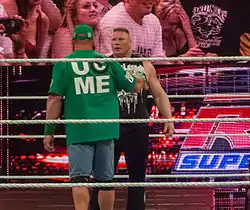
Grantland columnist David Shoemaker writes that while the path towards The Reality Era began with CM Punk's "insurrection", Brock Lesnar brought "a new era of wrestling legitimacy" when he returned in 2012.[32] Lesnar's on-screen manager, Paul Heyman, referred to him as the "most non-PG ass kicker of the PG Era"[33] and the violence in his return match with Cena at Extreme Rules 2012 caused the PPV to receive a TV-14 rating on iTunes.[34] While WWE considers The Reality Era to have begun in 2014;[17] Shoemaker writes that the Reality Era reached its apex with ascension of Daniel Bryan that year,[35] but Comicbook.com considers the end of the PG Era to have happened when CM Punk left the company after Royal Rumble 2014 and Joe Nguyen of The Denver Post believes Seth Rollins victory over Lesnar at WrestleMania 31 ended the PG Era.[19][18] It was during 2015 that John Cena slowly began to transition to a part time role and WWE began attempting to establish Roman Reigns as the face of the company, which received polarizing reception from fans and critics.[36][37][38]
Reception

The move to TV-PG programming has been singled out as WWE's most controversial decision amongst wrestling fans.[20] The transition to TV-PG caused some fans to support WWE's competitors,[39] with Pro Wrestling Torch writer James Caldwell commenting that WWE's programming looked like Barney & Friends or Blue's Clues when compared to their nearest competitor's at the time, Total Nonstop Action Wrestling.[5] Batista attributed his 2010 departure to the PG Era, and said that wrestling was "in a bad moment" during that time.[24]
Storylines during the PG Era have also been criticized. Inside Pulse wrote that characters were written better during the Attitude Era and each show was presented as being more important.[40] Responding to Vince McMahon's claims that modern shows are more "sophisticated", Sentinel Daily writer Dale E. Aragon said that "Someone should tell that to the audience."[41] Former WWF writer Vince Russo questioned whether McMahon watches the shows and compared a segment from them to Sesame Street.[42]
Although noting that the move was unpopular with some fans, Bleacher Report opined that it was the right thing to do given changing times, writing: "The world is more politically correct, parents are more cautious about what their kids are watching and advertisers are less willing to back controversial brands."[20] Shortly after the transition, Miami Herald writer Jim Varsallone said that the changes in programming were too subtle for casual fans notice and that he did not get complaints from fans.[8] WWE Hall of Famer Ted DiBiase supported the move to TV PG because he is a Christian Pastor and did not enjoy the raunchier programming.[43] Triple H also defended the PG-Era, stating that the story has to be good, no matter the rating.[44]
The transition to TV-PG became a subject of controversy during Linda McMahon's 2010 Senate campaign. US Senator Chris Dodd accused McMahon of trying to distance herself from professional wrestling,[12] while Superstar Billy Graham said that the move to kid-friendly programming was done so that she would be a more appealing candidate.[45] WWE denied these claims, stating that the 2008 transition to TV-PG occurred "long before McMahon announced her candidacy".[12]
References
- Robinson, Jon (May 12, 2015). WWE The Attitude Era. Penguin Books. p. 196. ISBN 9781465441386 – via Google Books.
- Sullivan, Kevin (March 31, 2014). WWE 50. Penguin Books. p. 210. ISBN 9781465427762 – via Google Books.
- Williams, Ian (August 5, 2020). "The Horrific Crime That Changed WWE Forever". Vice News. Retrieved December 31, 2020.
- Alvarez, Bryan; Storm, Lance (July 16, 2019). 100 Things WWE Fans Should Know & Do Before They Die. Triumph Books. ISBN 9781641252201 – via Google Books.
- Caldwell, James (December 10, 2008). "WWE News: "From the cradle to the grave" - WWE describes strategy of hooking kids on TV product". Pro Wrestling Torch. Retrieved December 25, 2020.
- "WWE goes PG". WWE. July 22, 2008. Archived from the original on September 1, 2015. Retrieved September 12, 2016.
- Pantoja, Kevin (November 16, 2018). "Kevin's Random Reviews: WWE SummerSlam 2008". 411Mania. Retrieved December 13, 2020.
- Bauder, David (October 14, 2009). "WWE now stressing family-style wrestling". Telegram & Gazette. Retrieved December 31, 2020.
- Graser, Marc; Graser, Marc (August 13, 2012). "WWE goes kid-friendly for CW Saturdays". Variety. Retrieved January 16, 2021.
- Powell, Jason (February 5, 2009). "John Cena says it was his call to change his finishing move name, predicts that three wrestlers will be WWE stars". Pro Wrestling Dot Net. Retrieved December 31, 2020.
- Ocampo, Jorge (February 26, 2009). "¿Por qué WWE cambia el nombre del PPV "One Night Stand" a "Night of Extreme"?". Súper Luchas (in Spanish). Retrieved December 31, 2020.
- Keating, Christopher (November 18, 2009). "Former Wrestler Takes On Mcmahon". Hartford Courant. Retrieved December 24, 2020.
- Eck, Kevin (March 27, 2010). "WWE takes a stand on chair shots to the head". The Baltimore Sun. Retrieved December 31, 2020.
- Eck, Kevin (April 6, 2011). "Triple H, The Undertaker Fined for Chair Shot at WrestleMania XXVII". The Baltimore Sun. Retrieved January 1, 2021.
- Indi, Rafael (July 23, 2019). "Dave Meltzer confirms that WWE wants to leave the PG era behind". Súper Luchas. Retrieved December 31, 2020.
- "Vince McMahon On WWE's Future: 'Not Going To Go Back To That Gory Crap'". WCBS-TV. July 25, 2019. Retrieved December 31, 2020.
- "What is your favorite WWE Era?". WWE. Retrieved January 14, 2021.
- Casey, Connor (April 14, 2020). "10 Great WWE PG Era Matches to Watch During the Coronavirus Quarantine". Comicbook.com. Retrieved December 31, 2020.
- Nguyen, Joe (May 10, 2015). "Goodbye, PG Era, WWE now entrenched in the Reality Era". The Denver Post. Archived from the original on March 21, 2016. Retrieved December 31, 2020.
- Mueller, Chris (July 20, 2018). "10 Years into the 'PG Era,' Did WWE Make the Right Call?". Bleacher Report. Retrieved December 31, 2020.
- Beaston, Erik (July 22, 2020). "The Legacy of WWE's 'PG Era' and What Comes Next 12 Years Later". Bleacher Report. Retrieved January 9, 2021.
- Pitts, Lan (September 6, 2017). "Five Years Ago Today, Edge Retired On Raw". Comicbook.com. Retrieved January 9, 2021.
- Benigno, Anthony (December 18, 2010). "Mike Mizanin turns his 'Real World: Back to New York' alter ego 'The Miz' into a WWE champion". New York Daily News. Retrieved January 9, 2021.
- Beltrán, William (June 16, 2011). ""Me fui de la WWE porque sentía que no encajaba con su Era PG.": Batista". Súper Luchas (in Spanish). Retrieved December 31, 2020.
- McCarrick, Michael (May 3, 2020). "Straight Edge Messiah: A Look Back at WWE's Most Underrated Character". Comic Book Resources. Retrieved January 9, 2021.
- Powell, Jason (August 18, 2013). "WWE SummerSlam 2011 Flashback: C.M. Punk vs. John Cena for the WWE Championship with Triple H as special ref, Randy Orton vs. Christian for the World Hvt. Championship in a No Holds Barred match". Pro Wrestling Dot Net. Retrieved January 14, 2021.
- "CM Punk | Superluchas- Parte 233". Súper Luchas. Retrieved January 9, 2021.
- Nemer, Paul (August 1, 2011). "Raw Results - 8/1/11". WrestleView. Retrieved January 9, 2021.
- Salgado, Sebastian (June 27, 2016). "A 5 años de la pipebomb de CM Punk – Cuando la realidad se mezcló con la ficción". Súper Luchas (in Spanish). Retrieved January 14, 2021.
- Sokol, Bryan (December 20, 2010). "TLC delivers highs, lows and a new champ". Slam! Sports. Canadian Online Explorer. Retrieved December 20, 2010.
- Oz, Drake (January 16, 2013). "10 Ways John Cena Has Hurt the WWE Product". Bleacher Report. Retrieved January 16, 2021.
- Shoemaker, David (July 16, 2015). "The Lesnar Effect: How Brock Has Led WWE to a New Era of Wrestling Legitimacy". Grantland. Retrieved January 16, 2021.
- Nemer, Paul (March 31, 2015). "WWE RAW Results - 3/30/15 (Night after WrestleMania 31)". WrestleView. Retrieved January 16, 2021.
- Martin, Adam (May 30, 2012). "WWE Extreme Rules PPV carrying TV-14 rating". WrestleView. Retrieved January 16, 2021.
- Shoemaker, David (May 14, 2015). "Reality Bites: Daniel Bryan, Adam Rose, and Heartbreak in Pro Wrestling". Grantland. Retrieved January 16, 2021.
- Shoemaker, David (October 28, 2015). "(W)WE Need a Hero: John Cena Is Gone. Who's Up Next?". Grantland. Retrieved January 16, 2021.
- Oster, Aaron (January 24, 2015). "Previewing WWE Royal Rumble 2015". The Baltimore Sun. Retrieved January 16, 2021.
- Wolf, Jacob. (August 16, 2016). "WWE's ongoing Roman Reigns problem". ABC News. Retrieved January 16, 2021.
- Desbordes, Michel; Richelieu, André (December 31, 2012). Global Sport Marketing: Contemporary Issues and Practice. Routledge. p. 143. ISBN 9780415507202 – via Google Books.
- "Forever Heel: Different Spin On WWF Attitude Era & WWE PG Era Comparison & Analysis". Inside Pulse. August 11, 2015. Retrieved January 14, 2021.
- Aragon, Dale E. (August 15, 2019). "Vince McMahon Talks "Blood and Guts" In Wrestling, Cody Rhodes Responds". Sentinel Daily. Retrieved January 14, 2020.
- Vince Russo [@THEVinceRusso] (July 26, 2019). "Did @VinceMcMahon ACTUALLY say the @WWE is going to a more "Sophisticated" Product? Bro-are you watching your own show? The 24/7 Championship is about as "Sophisticated" as a Bert & Ernie Backyard BBQ with Big Bird flippin' the burgers. Honestly, I think you've lost it, Pally" (Tweet). Retrieved January 14, 2021 – via Twitter.
- Bergonzi, Ezequiel. "Ted DiBiase: "I saw the potential of Steve Austin"". Súper Luchas. Retrieved December 31, 2020.
- Shoemaker, David (August 23, 2013). "'Getting Ready for a Car Crash': An Interview With Triple H". Grantland. Retrieved January 14, 2021.
- Pratt, Gregory (March 31, 2011). "Superstar Billy Graham Made It Big in Wrestling – Now the Steroids That Got Him There May Be Killing Him". Phoenix New Times. Retrieved December 24, 2020.

